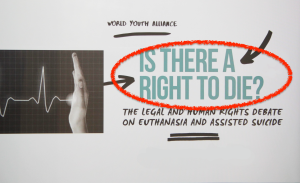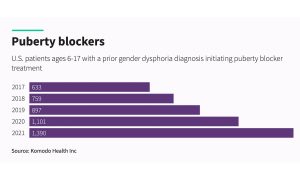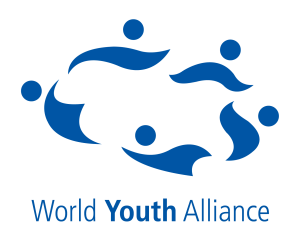Ljudsko dostojanstvo i kraj života – 1. dio: Uvodne napomene
This is a first in the series of three articles titled “Human Dignity and the End of Life”.
[tabs]
[tab title=”English”]
One thinker said the following about the end of life:
Just as we were helped to be born, so we have to be supported to die. We were not born knowing everything, we were helped to learn to talk, to learn to walk, feed, live with others. Neither in the last moments of life is different. Extreme vulnerability requires maximum solidarity. From a scientific point of view: professional ability; from a humane point of view: a sense of presence; from a spiritual point of view: the dimension of hope.[1]
The preceding sentences are the result of life experiences and reflections on human nature that remind us that the end of human life must be approached in an appropriate and comprehensive way. The end of life is a particularly sensitive period of human life that requires true solidarity and compassion. Speaking in general, people want to die peacefully and in a dignified way, without pain and suffering, for which modern medicine has developed palliative care as a special branch and an adequate approach of providing care to sick and dying people.
In the following paragraphs, we will try to understand how the existential question affects the meaning of man’s existence, look for the answers in modern science and find out why palliative care is an approach that fosters human dignity, forms a culture, and nurtures human life as a fundamental good.
Firstly, all living organisms (bacteria, fungi, plants and animals) are built from cells (according to the cellular theory of scientists Matthias Schleiden and Theodor Schwan), whereas the life cycle of cells ends in death.[2] While the death of human cells occurs daily (life expectancy of cells ranges from several hours to several years: a group of leukocytes, neutrophils, can live for several hours, skin cells live for several days, fat cells for several years, and some nerve cells live throughout the organism’s lifetime) and does not define the end of an individual’s life, the death of an organism occurs once in a lifetime and modern medicine defines it as the termination of all biological functions which define the organism. Due to the development of medicine, today we distinguish several types of death (cerebral, clinical, cellular, social), but roughly speaking, living organisms go through life processes of which the first is conception, then growth, development, aging and ultimately death.
One of the essential differences between human species and other living beings is the ability of self-realization in a specific living environment by planning and seeking a meaningful life and meaning in general. Human beings are capable of planning and conducting their lives with meaning and their own thoughts, and whoever thinks, also plans; those who plan well have a significantly greater chance of managing their life in a better way than those who cannot plan.
Secondly, the end of life is a moment at which the search for meaning may be experienced by an individual more radically than ever before. The experience of living through the end of life can be extremely unpleasant, marked by suffering and uncertainty. That experience is concrete and specific to an individual and therefore it is a unique opportunity for discovering meaning and taking a fundamental responsibility for his life, which makes difference and makes our freedom complete.
Ancient philosophers have taught that we are free in that which is given to us. Although we do not choose either disease or age, how we relate to them depends on our choice. The ultimate freedom consists in accepting what is given to us and then deciding on what we consider to be the most appropriate and most productive choices for our lives.
Medicine is excellent at finding organic causes and defining physiological disease forms, in discovering and enhancing medical, technical and pharmacological means of preserving life, treating illness, relieving pain, eliminating suffering, and effectively caring for the dying, and precisely identifying signs of human death, but every human being must find happiness, freedom and meaning of life for himself. Viktor E. Frankl, based on his own experience in concentration camps during the Nazi regime, came to the conclusion that those inmates who found the meaning of life and were able to say “yes” to life even in the toughest circumstances, survived more easily than those who were not able to do so. Encouraged by this experience, Frankl developed his own psychotherapy school that confronts a person with the question about the meaning of life, logotherapy.
Frankl lists three types of values that give meaning to our lives: experiences, creative work, and attitudes. Experiences are in the first place, because when we experience something beautiful we do not ask for meaning; our life at that moment is simply meaningful and fulfilled. In the second place is creative work. If I am creative and successful in something, then I experience life as meaningful. In the third place are attitudes through which I can find the meaning of life even in illness or other difficult situations, such as being a prisoner in an unjust and cruel captivity. It all depends on my attitude towards illness, captivity, or anything that was given to me. That being said, I have answered the question of the meaning of life only with general guidelines, since the answer is not the same for everyone, but instead requires personal effort with the will of the individual and, moreover, it needs to be lived during difficult times.
Thirdly, despite our plans, life constantly confronts us with surprises and challenges. Some of them are of particular importance for the very end of human life. The most difficult times lead to the greatest heroes, and that applies to a society as well, which is supposed to make the world a warmer, more humane, and more secure place to live.
We can unexpectedly find ourselves in a situation of powerlessness, such as traffic accidents or sudden life-threatening diseases, telling us what we care for, what we aspire to, and what we will achieve. A society that has recognized the value of taking care of their loved ones and strives to help those in need will be guided to the affirmation of life as a fundamental good. Specific situations and professions help us understand respect for dignity at the end of life. An example of a particular situation in which we best understand the role of society, family, friends and a dignity-based approach to the end of life is someone standing on a bridge prepared to jump to his death. In this critical situation, it is clear that a series of measures will be taken which will ensure saving the person’s life as soon as possible: call emergency services, alert the public, talk to the person in crisis. The reaction of most people to the person on the bridge is: I will do everything to save this person! And this is an appropriate reaction because it shows the recognition of the critical situation in which the person is found, and that this person needs our compassion and our help. Euthanasia and its legal regulation are completely opposite approaches to the end of life as they turn it in the opposite direction. Rather than having the help of society in the aforementioned critical situation, the desperate person will wonder: Will anyone help me? Will they let me jump? Will they help me jump?
[1] Tomašević, Luka, Do kada produžavati život?, Služba Božja 45 (2004.), br. 2, pp. 145-146.
[2] Except for the examples such as dedifferentiation process or plant tissue or process in the species of jellyfish Turritopsis nutricula, which, due to the ability of cells after maturation and reproduction, can take on a colonial lifestyle.
[/tab]
[tab title=”Hrvatski”]
Jedan je mislilac o svršetku života rekao sljedeće:
Isto kao što smo bili pomagani da se rodimo, tako moramo biti pomagani i da umremo. Mi se nismo rodili znajući sve, pomagali su nam da naučimo govoriti, da naučimo hodati, hraniti se, živjeti s drugima. Ni u posljednjim trenucima života nije drukčije. Kod krajnje ranjivosti dolazi do maksimalne solidarnosti. Sa znanstvene točke gledišta: stručna sposobnost; s humane točke gledišta: osjećajno prisustvo; s duhovne točke gledišta: dimenzija nadanja.[1]
Prethodne rečenice rezultat su životnog iskustva i promišljanja o čovjekovoj biti koje podsjećaju da kraju ljudskog života valja pristupati na primjeren i sveobuhvatan način. Kraj života posebno je osjetljivo razdoblje ljudskog života koji zahtijeva istinsku solidarnost i suosjećajnost. Govoreći općenito ljudi žele umrijeti mirno i dostojanstveno, bez boli i patnje, zbog čega je moderna medicina razvila palijativnu skrb kao posebnu granu i adekvatan pristup u pružanju njege bolesnima i umirućima.
U sljedećim odlomcima pokušat ćemo razumjeti kako ovo egzistencijalno pitanje pogađa smisao čovjekovog postojanja, koji su odgovori moderne znanosti na njega i zašto je palijativna skrb pristup koji njeguje ljudsko dostojanstvo, formira kulturu i njeguje čovjekov život kao temeljno dobro.
Prvo, svi živi biološki organizmi (bakterije, gljive, biljke i životinje) građeni su od stanica (prema staničnoj teoriji znanstvenika Matthiasa Schleidena i Theodora Schwana), a životni ciklus stanice završava se smrću.[2] Dok se smrt ljudskih stanica odvija svakodnevno (životni vijek stanica kreće se u rasponu od nekoliko sati do nekoliko godina – skupina leukocita, neutrofili, mogu živjeti nekoliko sati, stanice kože žive do nekoliko dana, masne stanice nekoliko godina, neke živčane stanice žive cijeli životni vijek organizma) i ne definira kraj života jedinke, smrt organizma nastupa jednom u životu i moderna ga medicina definira kao prestanak rada svih bioloških funkcija koje definiraju organizam. Zahvaljujući razvoju medicine danas razlikujemo nekoliko vrsta smrti (cerebralnu, kliničku, staničnu, socijalnu), ali grubo govoreći, živi organizmi prolaze kroz životne procese od kojih je prvi začeće, zatim rast, razvitak, starenje i na koncu smrt.
Jedna od bitnih razlika između čovjeka i drugih živih bića jest sposobnost ostvarivanja u specifičnom životnom okruženju putem planiranja i potrage za smislenim životom te smislom općenito. Čovjek je sposoban planirati i voditi svoj život smisleno i vlastitim mislima, a tko misli, taj i planira, i tko dobro planira – ima bitno veću šansu da će svojim životom bolje upravljati nego onaj tko ne umije planirati.
Drugo, kraj života pozicija je iz koje se traženje smisla pojedincu može nametnuti radikalnije nego ikada prije. Iskustvo koje doživljavamo na kraju života može biti izrazito neugodno, obilježeno patnjom i neizvjesnošću. Ono je konkretno i specifično za pojedinca zbog čega je jedinstvena prilika za otkrivanje smisla i zauzimanja stava koji čini razliku te upotpunjuje našu slobodu.
Antički filozofi učili su kako smo slobodni u onome što nam je dano. Doduše ne biramo ni bolest ni starost, ali kako se prema njima odnosimo ovisi o našem izboru. Konačna sloboda sastoji se u tome da prihvatimo ono što nam je dano, a zatim se odlučimo za ono što smatramo prikladnim i najizvrsnijim odabirom za naš život.
Medicina je izvrsna u traženju organskih uzroka i definiciji fizioloških oblika bolesti, u otkrivanju i unapređivanju medicinskih, tehničkih i farmaceutskih sredstava za očuvanje života, liječenje bolesti, ublažavanje bolova, uklanjanje patnji, učinkovito skrbljenje oko umirućih i precizno utvrđivanje znakova ljudske smrti, ali svaka ljudska osoba za sebe mora pronalaziti vlastitu sreću, slobodu i smisao života. Viktor E. Frankl na temelju vlastitog iskustva u koncentracijskom logoru za vrijeme Trećeg Reicha došao je do zaključka da su lakše preživjeli oni zatvorenici koji su našli smisao života i u najtežim okolnostima ipak rekli „da“ životu, od zatvorenika koji to nisu bili u stanju. Potaknut ovim iskustvom, Frankl nakon dolaska na slobodu razvija vlastitu školu psihoterapije koja čovjeka postavlja pred pitanje o smislu života – logoterapiju. Frankl navodi tri vrste vrednota koje našem životu daju smisao: doživljaji, stvaralačka djela i stavovi. Na prvom mjestu su doživljaji, jer kad doživimo nešto lijepo, u tom trenutku ne pitamo za smisao, život nam je tada jednostavno smislen i ispunjen. Na drugom su mjestu stvaralačka djela. Ako sam kreativan, kad mi nešto uspije, tada doživljavam život smislenim. Na trećem su mjestu stavovi putem kojih mogu naći smisao života i u bolesti ili teškim situacijama, kao npr. zatvorenici u nepravednom i surovom zatočeništvu. Sve ovisi o mom stavu prema bolesti, zatočeništvu, prema onome što mi je dano. Ipak, na pitanje o smislu života odgovorili smo samo kroz općenite smjernice jer odgovor on nije svakom jednak, traži osobni napor uz volju pojedinca te ga usto treba i živjeti, s posebnim umijećem i osjetljivošću za vrijeme teških razdoblja.
Treće, unatoč planovima, život nam neprestano postavlja nova iznenađenja i izazove, a neki od njih posebnog su značaja upravo za kraj ljudskog života. Po najtežim trenucima poznaju se najveći junaci, ali i uloga društva, koje bi svijet trebalo činiti toplijim, ljudskijim i sigurnijim mjestom.
Tako se nepredviđeno možemo naći u situaciji nemoći u kojoj se uozbiljuju planovi i namjere društva koji nam govore do čega držimo, kamo težimo i što ćemo postići. Društvo koje je prepoznalo smisao vođenja brige o svojim bližnjima i teži pomaganju u nevolji, vodit će se afirmacijom života kao temeljnog dobra. Specifične situacije i zanimanja pomoć su nam u razumijevanju dostojanstvenog pristupa kraju života. Specifična situacija iz koje ponajbolje razumijevamo ulogu društva, obitelji, prijatelja i dostojanstven pristup kraju života jest pokušaj samoubojstva skokom s mosta. U toj kriznoj situaciji svima je jasno kako će u što kraćem roku poduzeti niz mjera koje osiguravaju i spašavaju život unesrećenom: pozvati hitne službe, upozoriti javnost, razgovarati s unesrećenim. Reakcija većine ljudi prema osobi koja se nalazi na mostu kako bi počinila samoubojstvo jest: učinit ću sve kako bih ovom čovjeku spasio život! I to je primjerena reakcija jer pokazuje prepoznavanje kritične situacije u kojoj se netko nalazi i da taj netko treba naše suosjećanje i našu pomoć. Eutanazija i njeno zakonsko reguliranje potpuno je suprotan pristup kraju života od očekivanog i okreće ga u suprotnom smjeru. Umjesto da u navedenoj kritičnoj situaciji osoba očekuje pomoć od društva, mora se pitati: Hoće li mi tko pomoći? Hoće li mi biti dopušteno skočiti? Ili ću biti gurnut s mosta?
[1] Tomašević, Luka, Do kada produžavati život?, Služba Božja 45 (2004.), br. 2, pp. 145-146.
[2] Izuzev primjera kao što su dediferencijacija biljnog tkiva ili proces u vrste meduze Turritopsis nutricula, koja zbog sposobnosti stanica nakon sazrijevanja i razmnožavanja može poprimiti kolonijalni način življenja.
[/tab]
[/tabs]
Written by Luka Poslon, head of the Bioethics Team of WYA Croatia








